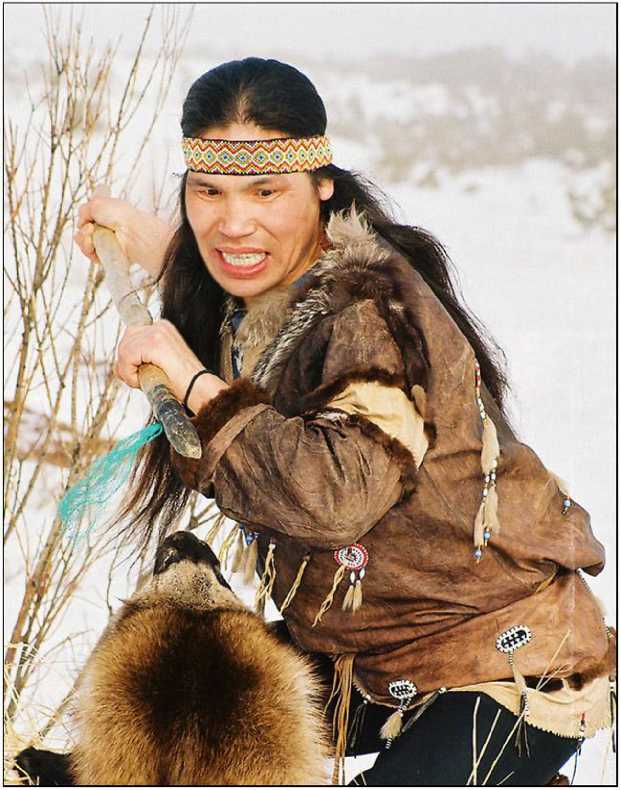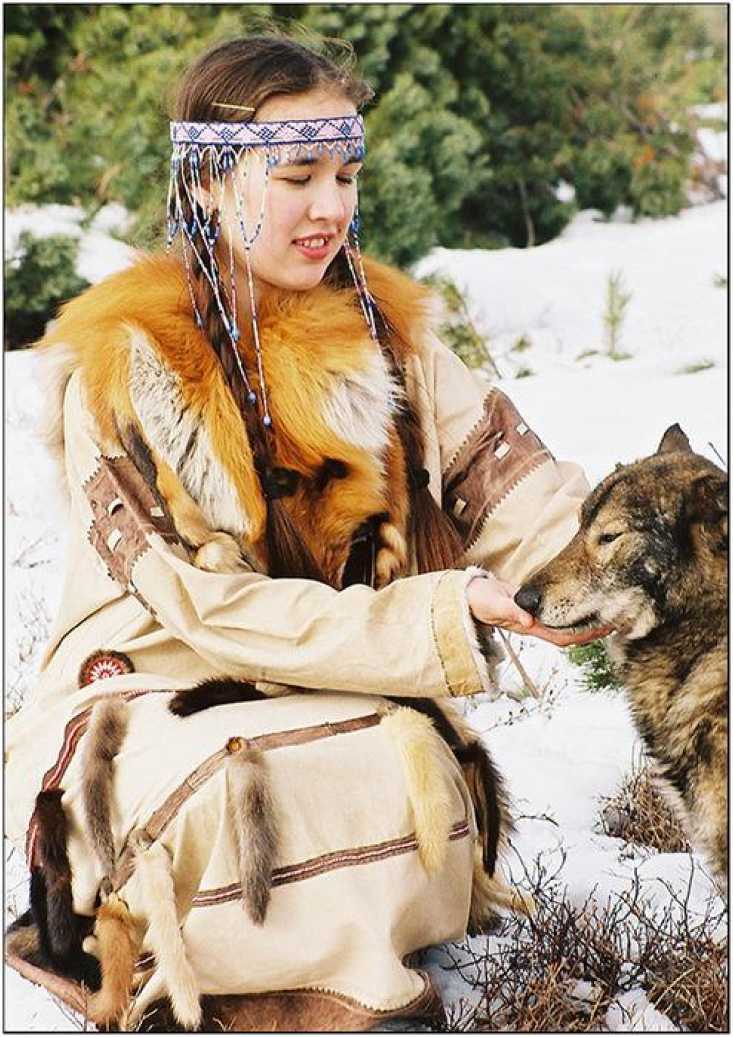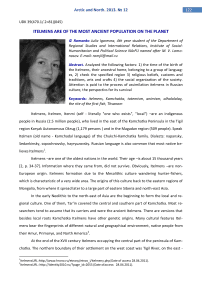Itelmeni - are of the most ancient population on the planet
Автор: Romanko J.I.
Журнал: Arctic and North @arctic-and-north
Рубрика: Indigenous people of the Arctic and North
Статья в выпуске: 12, 2013 года.
Бесплатный доступ
Analyzed the following factors: 1) the time of the birth of the Itelmens, their ancestral home, belonging to a group of languages, 2) check the specified region 3) religious beliefs, customs and traditions, arts and crafts 4) the social organization of the society. Attention is paid to the process of assimilation itelmens in Russian culture, the perspectivs for its survival.
Itelmens, Kamchatka, totemism, animism, alhalalalay, the rite of the first fish, Thsanom
Короткий адрес: https://sciup.org/148320342
IDR: 148320342 | УДК: 39(470.1/.2=81)(045)
Текст научной статьи Itelmeni - are of the most ancient population on the planet
Itelmens, Itelmen, Itenmi (self - literally "one who exists", "local") –are an indigenous people in Russia (2.5 million people), who lived in the east of the Kamchatka Peninsula in the Tigil region Koryak Autonomous Okrug (1,179 persons ) and in the Magadan region (509 people). Speak Itelmen (old name - Kamchadal language) of the Chukchi-Kamchatka family. Dialects: napansky, Sedankinsky, sopochnovsky, hayryuzovsky. Russian language is also common that most native believes Itelmens1.
Itelmens –are one of the oldest nations in the world. Their age –is about 15 thousand years [2, p. 34-37]. Information where they came from, did not survive. Obviously, Itelmens –are nonEuropean origin. Itelmens formation due to the Mesolithic culture wandering hunter-fishers, which is characteristic of a very wide area. The origins of this culture back to the eastern regions of Mongolia, from where it spread later to a large part of eastern Siberia and north-east Asia.
In the early Neolithic to the north-east of Asia are the beginning to form the local and regional culture. One of them, Tar'in covered the central and southern part of Kamchatka. Most researchers tend to assume that its carriers and were the ancient Itelmens. There are versions that besides local roots Kamchatka Itelmens have other genetic origins. Many cultural features Itel-mens bear the fingerprints of different natural and geographical environment, native people from their Amur, Primorye, and North America2.
At the end of the XVII century Itelmens occupying the central part of the peninsula of Kamchatka. The northern boundary of their settlement on the west coast was Tigil River, on the east - the river Uka. In the south of the settlement Itelmens stretched to the very tip of the peninsula. Their total population at the end of the XVII century was 12-13 thousand people. With the entry of Kamchatka in the Russian state, most of the territorial groups Itelmens was in the zone of the intensive contacts with the Russian. Currently Itelmens mainly concentrated in the villages of Ko-vran, Tigil, Palau, Khairyuzovo Tigilskiy region of Kamchatka region, where most of the younger generation are the descendants of mixed marriages3.
Pic. 1. The map of the settlements of the Itelmens. URL:
In determining the classification accessories Itelmen language, there are different interpretations. A more traditional assessment of its entry into the Chukchi-Koryak rpuppy Paleo-Asiatic languages (Itelmen, chykotsky, Koryak, Kerek) is currently being revised by linguists consistently. Special studies vocabulary, phonetic system, sound system Itelmen language compared to the Chukchi and Koryak suggest that with them he finds areal compliance (a consequence of the ethnic and cultural contacts) rather than genetic relationships (common origin). However, the attitude towards palaeoasiatic Itelmen language, even at the level of the classification of its isolation, is not in doubt4.
Itelmens believed, tha the earth plane, but thought the wrong side of our flat earth - is underground sky, and when there is summer, winter is here, and vice versa. Rain penetrates the ground and underground waters the earth that is in full compliance with the Slavic-Turkic mythologies of the Underworld Ocean. There are also stories of the Flood, and the salvation of some warnings on rafts, as the peoples of Asia Minor. The only thing familiar to them constellation - Ursa Major, which they call Khan, which means "moving constellation." They attributed the action of the tides in the ocean of the funnel, which is then sucked into the water, then releases it back. World Itelmens considered eternal soul - immortal.
Religious ideas and practices Itelmens based on animism - the belief in the afterlife underground, good and evil spirits, totemism - faith in affinity with a particular animal, honoring the hosts of the sea and forest animals. Their greatest god-demiurge - Kutka [3, p. 366] or Kutga going on, maybe from the Mongolian "kut" - frost. It must have seemed cold the first settlers in Kamchatka main determinant of their lives. Constant ridicule, which Itelmens allowed in relation to their god, talking about it almost Dionysian spirit obscene stories, explained, perhaps, by the victory over frost after Kutka taught to build their underground dwellings. Having taught, Kutka Koryak left the country, where it is much colder than in Kamchatka.
Wife of Kuthi - Hahi (maybe from an old-Turkic "Hut" - the beauty, order, harmony). The myth says that she was very beautiful and smart. His son Dezelkut, perhaps, from "tec" - likeness, image, "kut" - like Kuthi. Goblin, just as the Slavs and Turks, lured into the thicket - "Ushahchu" is, perhaps, in compliance with "uh" (protobulgarskoe) - owl. In the clouds lives Villyukay ("Willem" -death), because, believe me, after the death of a person moves to the sky. The Lord of the Underworld - Hatch (without matches)5.
It should be noted that Itelmens in religious beliefs have similarities with other nations. This applies to the characters and places of worship Itelmen mythology: 1) Raven - the central character in the myths of the certain people of the northern Asia and North America, primarily in Paleo Chukchi-Kamchatka group (Chukchi, Koryak, Itelmens) in Asia, at the north-western Indians (mainly Tlingit way, but also the Haida, Tsimshian, kvakiyutl) severnyht Athabascan and Eskimo part 2) Mitg - in myths Itelmens fish-god of the sea, which is inhabited by fish of the sea and the river. Depended on him luck in fishing, and 3) Pilyachuch - in the myths Itelmens host of the terrestrial animals, the patron of wild deer, thunder god, and 4) Sinanevt - the myths and the Koryak
Itelmens eldest daughter Raven, one of the central characters of many myths. It performs good things 5) Utleygon - in the myths Itelmens spirit-creator6.
"They worship the whale and killer whale out of fear, because these animals are upset their canoes. They kneel in front of the fear of bears and wolves, having a number of spells, they began to speak of. All of these animals, they never call them by these names, and when he saw them, just pronounce the word "Sipang" ("O woe!"). They are very funny and loons began to speak firmly believe that all the animals understand their language. Ravens and crows they express their gratitude for what they portend good weather and not too heavy frost. Wagtails they are grateful for the spring, convinced that these birds bring with them this time of year. They think they should not kill and eat any land or water animal without first apologizing to him and asking him not to take offense at them, and then to treat it with pine nuts and other things to pay for its meat and hide, so that the animal thought that it was visited by them only at a party and thus would not put the relatives of the people "[4].
"... Itelmens respectfully refer to anything that can either cause them great harm, or be of great benefit. They worship the fire and bring it to the victim faces sable, fox and all sorts of animals and pelts can immediately find out if the animal caught baptized or unbaptized Itelmen. If the combustion of wood hisses, it portends good fortune, while the Yakuts, by the contrast, see this as a harbinger of misfortune. Itelmens would have around always had good luck, because they burn extremely raw, always sizzling firewood.
They also exist some idols. When they build a tent, and then in front of the hearth drive a stake into the ground, which they call Asusunagch, which means the home of God. By cola they tie sweet grass, Ehyeh, sometimes it also smeared with fat and blood, and believe that he is for it gives them every success in the fishery. This Asusunagch - Hanteya son, who lives in the clouds and helping Villyukayu produce thunder.
The residents of Cape Lopatka and shallow Strait of worship and began to speak them, passing by the places they are constantly shamanism and thrown into the water, "tobacco" - chips, reminiscent of the Nuremberg fan of flies. These chips are also revered as a god, because it appears to them in the form of the curls of the last. This God they call Inaul. If someone gets sick, it is in honor of the god produces new chips.
Some religious Itelmens currently manufactures small, bagged gods. They are fed and watered, and no one will never scold a heretic if he thinks of itself make one or another deity more or less "[4].
Christianization through the missionary activity begins in the 2nd quarter of the XVIII century. By the middle of the century it was spread throughout the peninsula and the northern Kuril Islands. Christianization was accompanied by the introduction of tax incentives for the new converts. In most of the prisons were opened schools that trained together Russian and Kamchadal children7.
After treatment of the Itelmens in 1740-1747 in the Christianity began to spread in the Orthodox rites - baptism, wedding, funeral service. Itelmens calmly converted to Christianity, although it retained their pagan customs. Already in the first quarter of the nineteenth century, travelers have noted in Kamchadal villages Orthodox cemeteries. A tradition at the baptism given to children Russian names.
In the last decade of the twentieth century., along with the return of the interest in Orthodoxy, there is an intensive process of the revival of the ancient pagan elements of the culture8. Funeral feasts of the Itelmens described in great detailsby C. P Krasheninnikova. They were held once a year in November. For Itelmens it was an important event. All summer work is completed, and before making the ceremony it was impossible to do anything or go for a visit - a sin. Some travelers called this event "cleanser of sins," others - "whale feast."
The holiday began with a ritual of the purification dwellings, which made old men and women holding tonshich tufts of grass. Then out of the house through the upper ladder pulled out and instead put the raw birch trunk, took out all the dog's harness and all that was associated with riding on dogs. Eat only vegetarian food and fish. Researchers believe that these actions mimic a n-cient times, when people did not know the dog and hunting. At a later view of the world points to action with a stuffed whale. Around midnight, a woman entered the tent, to the back of which was tied a stuffed whale, pre-made from sweet grass, fish and seal meat. A woman must crawl to him around the hearth. It is followed by two men who beat on "whale" and shout at the Raven. One of the important details of the ceremony was the production of a new god figurines Hunt, who carved out of wood from the old one. Rounding out the ritual dance of the total under the shouts of "alhalalalay." That was the name revived in 1987 and developed a holiday9. For Itelmens of the Kamchatka Peninsula Alhalalalay holiday marks the completion of chores, harvesting wild plants and fish to the harsh winter of Kamchatka 10. In November, just start the "second new year" (year in Itelmens was divided into two halves, summer and winter). Perhaps, once the top half of the winter was considered the beginning of the year, but after moving to the peninsula and to simplify everyday life was seen as the beginning of the year in May, a month when you can open trades. [1]

Pic. 2.Traditional man costume. URL:
The ritual of the first fish was held in late spring or early summer. This is due, primarily, to the laws of nature. It was at this time the fish starts to go into the river, that the Itelmens is a vital event. On the river put chiruchi (traps), or the so-called mordushki. Once there the fish is cut: cut off his head, take out the eggs and viscera. Then, cut the grass, collect different leaves and weave it all into a long braid. At the same time showing great care to eggs remained intact.
Then the tribe goes to the river to push through a woven braid against the flow of water, while loudly shouting: "Oh, how many fish sailed a lot, a lot of fish!" After going some distance u p-stream, hang spit right there on the tree. What is interesting in action is preferable to present a pregnant woman, for power and communication with the spirits of the good increases. Then throw into the fire gods food, eating soup prepared from fallen into the trap of the first catch. Now you can be sure there will be many salmon in the rivers11.
Folklore Itelmens presented the myths retold in Russian researchers of the XVIII century and tales recorded on Itelmen in the twentieth century. Currently, mythological scenes of the creation of the world are preserved only in fairy tales and rites, probably due to the Christianization of embracing Itelmens and a sharp and rapid decline in their numbers due to disease in the second half of the XVIII century and subsequent assimilation.
In the mythology, the main character acts Kutkh, or Raven. He appears as a demiurge (creator), creator of Kamchatka and at the same time as the trickster - crook, a liar, a buffoon-nik, a shifter that carries the good and evil, wisdom and folly. Genre legend for Itelmen folklore is not typical. Can only be called a legend Tylvale - local strongmen, heroes, himself no one else is attacking, but always conquers all who are trying to attack him12.
The most advanced types of crafts –are embroidery, weaving grass and leather straps, application of fur, bone carving and wood, embossed on birch. Remarkable examples of art processing of products from soft materials are preserved in museums leather items Itel'men sleds. Samples of carving and painting on wood are mainly on dog sleds. Catches their similarity to the patterns on fur garments and patterns, woven from leather straps13.
Itelmens settlement at the beginning of the XVIII century meets family communities. They settled on the same river and were related by blood and unity of fishing grounds. Usually, all the relatives lived in the same semi-dugouts. The names of most outposts match names of the rivers in which they were located. The organizer of the population redoubt was the elder. In his tent to take all decisions governing the internal life of a jail, discussed all socially important cases, there were celebrations jail population14.
Now ethno-social situationof the Itelmens in the villages is no different from other native villages
Koryak Autonomous Okrug. Unemployment, lower living standards, degradation of the social services, increased morbidity and mortality - common issues for all indigenous peoples of the county.

Pic. 3. Traditional women costume. URL:
Itelmens together with other small nations Koryak Autonomous District are taking part in the work of its representative and executive bodies. Itelmenka V.T. Bronevich was the only governor of a female in Russia. Itelmens work as part of the district administration, led by rural administrations Kovran village, some other settlements.
Itelmens among the first in the country (1989) created their own social organization - the Council of the revival Itelmens Kamchatka "Thsanom" actively involved in the overall movement of the peoples of the North, Siberia and the Far East for its economic and cultural rights. The main direction in the Council - the revival of the ethnic culture Itelmen in all spheres of the public life, the promotion of national enterprises on the basis of traditional occupations and local natural resources. "Tkhsanom" maintains close contacts with foreign organizations of indigenous people, and participates in the international scientific projects. To date Itelmens live by the Communities [5].
It can be concluded that Itelmens, in fact, people are dying, but they have a very high level of the ethnic identity. They are fighting to preserve their identity, culture and language.
Список литературы Itelmeni - are of the most ancient population on the planet
- Arsyukhin E. Kamchatka: Ulus remote. Historical Sketch. URL: http://archeologia.narod.ru/kamchat.htm (date of access: 03.05.2011).
- Bogachyova N. Kiselev, G. / / Ethnosphere. 2010. Number 9. p. 34-37.
- Muraveva T.V. Myths and Slavic people of the North. Moscow: Veche, 2005. p. 366-368.
- Steller G.V. Description of the Land of Kamchatka / Georg Wilhelm Steller. URL: http://www. beringisland.ru/history/peoples/steller/ozk/24.shtm (date of access: 05.03.2011).
- Sulyandziga R.V., D. Kudryashov, Sulyandziga P.V. Indigenous People of the North, Siberia and Far East of the Russian Federation. Overview of the current situation. M, 2003. 142p. Website: Association of Indigenous Peoples of the North, Siberia and the Far East. URL: http://www.raipon.info/narody/narody-severa-sibiri-i-dalnego-vostoka-rf/225-2009-08-13- 13-17-37.html (date of access: 05/03/2011 ).


